 HOME: www.hiltonpond.org |
|||
PRESENTATIONS about
OTHER BIRDS
 HOME: www.hiltonpond.org |
|||
PRESENTATIONS about
OTHER BIRDS
|
Even if you can't tell a hawk from a heron, you'll be enchanted by natural-educator Bill Hilton Jr.'s presentation on The Excitement of Ornithology. In this beautifully illustrated slide talk, you'll see up-close views of some of North America's most spectacular birds, and you'll get all sorts of tips on how to remember how to identify them next time they show up at your backyard feeder. The presentation includes hints on how to attract birds to your neighborhood, how to select a good field guide and binoculars, and the best places to go to see various bird species, including Hilton Pond Center for Piedmont Natural History. (NOTE: This talk is appropriate for any audience, but can be targeted especially for groups of students who know little of the wild birds around them.) (Photo © Hilton Pond Center) Male Yellow Warbler Back to Top of Page 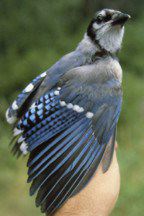 Blue Jays Ain't All Bad Blue Jays Ain't All BadAlthough most folks don't really appreciate Blue Jays, Cyanocitta cristata, there's more to them than meets the eye. During a graduate research project in central Minnesota, Bill Hilton Jr. banded and color-marked nearly 1,000 free-flying and nestling Blue Jays. In the four-year study, more than 400 nests were found in a 60-hectare (110-acre) site--likely the densest-known nesting populations for the species. Many nests were lost, apparently due to predation by crows (Corvus brachyrhynchos), feral cats (Felis domestica), or gray squirrels (Sciurus carolinensis). During this Blue Jays Ain't All Bad presentation from Hilton Pond Center for Piedmont Natural History, you'll learn all about how a field research can reveal a bird's mating strategies, its everyday behavioral patterns, and other fascinating facts. (Photo © Hilton Pond Center) Juvenile Blue Jay Back to Top of Page 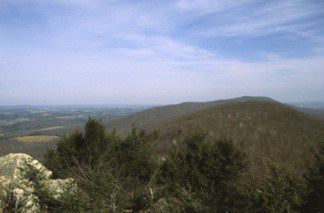 Feathers in the Wind: The Story of Hawk Mountain Sanctuary Feathers in the Wind: The Story of Hawk Mountain SanctuaryHawk Mountain Sanctuary, the world's first refuge for birds of prey, is the subject of Feathers on the Wind. The Sanctuary has been an international mecca for birdwatchers since it was established in 1934 to protect the slaughter of tens of thousands of hawks, falcons, and eagles that migrate through each fall. During this talk, you'll learn the fascinating history of how a woman sufragette held off the shooters and protected this scenic vista for posterity. There are plenty of photos of birds of prey to test your ability to identify the nearly 20 species of raptors that have been spotted flying past North Lookout. This presentation is by Bill Hilton Jr. of Hilton Pond Center for Piedmont Natural History, who once served as Hawk Mountain's Director of Education. (Photo © Hilton Pond Center) View from Hawk Mountain's North Lookout Back to Top of Page 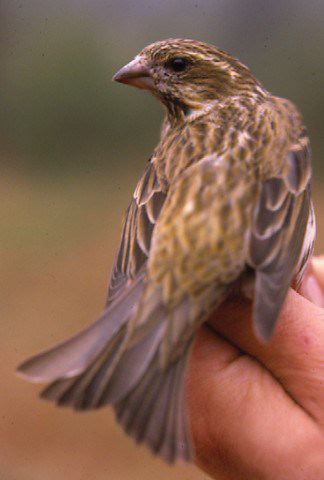 Winter Site Fidelity in Purple Finches, Carpodacus purpureus Winter Site Fidelity in Purple Finches, Carpodacus purpureusPurple Finches (Carpodacus purpureus) typically breed in the northeastern U.S. and Canada and overwinter down the Eastern Seaboard. Some years, migrant Purple Finches arrive at Hilton Pond Center for Piedmont Natural History in late November, but often they trickle in after the first of the year. Some winters, they come in great numbers, while in other years they are very scarce. In this talk, you'll help decide some of the factors that may affect when--and if--Purple Finches migrate and master bird bander Bill Hilton Jr. will explain all about Winter Site Fidelity in Purple Finches, one of North America's most popular feeder species. (Photo © Hilton Pond Center) Purple Finch, unknown age & sex Back to Top of Page 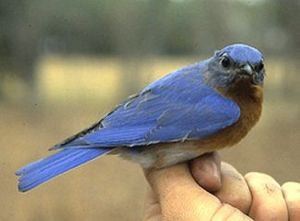 Bluebird Trails: Conservation in Action Bluebird Trails: Conservation in ActionEastern Bluebirds, Sialia sialis), are a favorite species for even the part-time bird watcher--especially since they will nest in boxes made by humans. Primarily because of the loss of natural cavities in large trees and elsewhere, bluebird populations declined in the second half of the 20th century but rebounded nicely when nestboxes were erected and Bluebird Trails were established in the eastern U.S. This talk by educator-naturalist Bill Hilton Jr. covers everything from bluebird natural history to how to build a nestbox , plus the results of bluebird banding research at Hilton Pond Center for Piedmont Natural History. (Photo © Hilton Pond Center) Male Eastern Bluebird Back to Top of Page 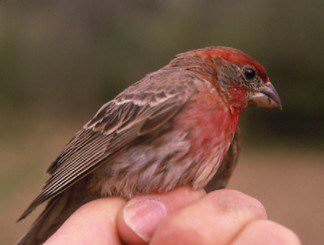 Trends in Eastern Populations of House Finches, Carpodacus mexicanus Trends in Eastern Populations of House Finches, Carpodacus mexicanusHouse Finches (Carpodacus mexicanus), which were introduced to New York City from the West in 1940-1941, now breed commonly in many eastern states and occur in winter at bird feeders with Purple Finches (C. purpureus). In South Carolina, Purple Finches are migrants, but House Finches are both resident and migrant. In this presentation, you'll learn about some of the more than 7,500 House Finches banded by Bill Hilton Jr. at Hilton Pond Center for Piedmont Natural History and explore whether the species had an effect on local native bird populations, whether they've found an "empty niche," and if there are any noticeable Trends in Eastern Populations of House Finches. (Photo © Hilton Pond Center) Male House Finch Back to Top of Page 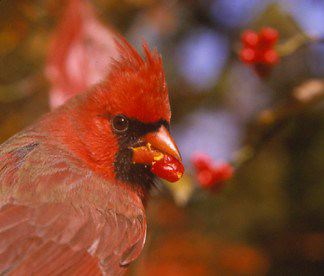 Watching Winter Birds: Better Than Television! Watching Winter Birds: Better Than Television!Birdwatching is a favorite pastime for many folks--especially those that have a backyard feeder. In this talk, you'll learn all about how to attract birds to your backyard in winter--all the while marveling at spectacular close-up photography of birds that occur at Hilton Pond Center for Piedmont Natural History and that you're likely to see at your own feeding station. The presentation includes plenty of hints about how to make and properly place feeders and which winter food works best for which bird species. (Photo © Hilton Pond Center) Male Northern Cardinal & Dogwood Berries Back to Top of Page |
|
Make direct donations on-line through
Network for Good: |
|
|
LIKE TO SHOP ON-LINE?
Donate a portion of your purchase price from 500+ top on-line stores via iGive: |
|
|
Use your PayPal account
to make direct donations: |
|
 post questions for The Piedmont Naturalist |
Join the |
Search Engine for |
|
|